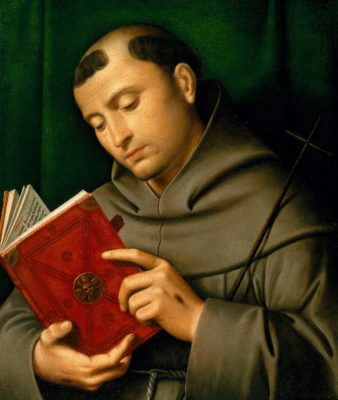Giovanni Busi, called Giovanni CARIANI (Fulpiano al Brembo, around 1485 – Venice, 1548 ?)
Originally from Bergamo, Giovanni Cariani was above all active in Venice, where he is registered as a painter from 1509 to 1517, then from 1524 until his death.
One can clearly see in his works from the first decade of the 15th century the imprint of Giovanni Bellini and of Lotto, for example in the Sacred Conversation from Venice (Galleria dell’Accademia) or the Portrait of two Venetian gentlemen (Paris, Musée du Louvre).
The influence of Titian and the “intellectualism” of Giorgione appear between 1510 and 1515, but his colours remain very lively in the tradition of Bergamo. Mauro Lucco and Alessandro Ballarin have brought to light the role of Sebastiano del Piombo in Cariani’s development during this second decade of the 15th century. Let us mention from this period in particular the Portrait of a young man (Berlin, Staatliche Museen, Gemäldegalerie), the Lute Player (Strasbourg, Musée des Beaux Arts) and The Seduction (St. Petersburg, Hermitage Museum). From 1517 to 1524 he settled in Bergamo, where he painted the Altarpiece of San Gottardo (Milan, Pinacoteca Nazionale di Brera ; around 1517-1518), the Virgin suckling the Child and the Christ carrying the cross (Bergamo, Accademia Carrara), the Portrait called of the Albani family, signed and dated 1519 ; Bergamo, Roncalli collection). He then abandoned the Venetian “sfumati” for stronger colours and a more affirmative realism, of Lombardian generation, which announces Caravaggio ; here are the extraordinary Concert (New York, Metropolitan Museum of Art), the Three saints (St. Sebastian, St. Roch and St. Marguerite) from the Musée des Beaux Arts in Marseille, around 1520 (where one can still see the influence of Titian in the white linen which flows to the ground and balances St. Sebastian), the Portrait of Giovanni Benedetto Caravaggi (around 1517-1518) and the Virgin and Child with a donator (signed and dated 1520 ; both in Bergamo, Accademia Carrara), as well as the very beautiful Portrait of Giovan Antonio Caravaggi (Ottawa, National Gallery of Canada ; around 1521-1522).
In the third decade, while the artist is again documented in Venice in 1523 and 1527, are situated the Adoration of the Shepherds and the Woman in a landscape (Berlin, Staatliche Museen), which are witness to his contacts with Palma, the Visitation (Vienna, Kunsthistorisches Museum) and the Virgin sewing (Rome, Galleria di Palazzo Barberini). Having returned to Bergamo around 1528, he acquired more northern accents in the Glorification of the Cross (Accademia Carrara), the Virgin with Doves (Bergamo, cathedral) and the Virgin and Child with St. Sebastian (Paris, Musée du Louvre). The canvasses from the 30s, like the Veronica from the Ambrosiana in Milan, stand out with their dramatic animation. From the end of his career date the Portrait of an old man (Vienna, Kunsthistorisches Museum, Gemäldegalerie ; 1536), the Portraits of men from the National Gallery of Oslo, the North Carolina Museum of Art in Raleigh and from the Museo del Castello in Milan.
St. Francis of Assisi.
Circa 1510-1515.
Oil on panel.
54 x 43 cm (21 1⁄4 x 16 7/8 in.).
Bibliography : Bergamo. L’altra Venezia. Il Rinascimento negli anni di Lorenzo Lotto, 1510-1530, exhibition under the direction of Francesco Rossi, Milan, Skira, 2001, pp. 156-157 (reproduced p. 157).
This work was attributed to Giovanni Cariani, in the early years of his sojourn in Venice, by Mauro Lucco and Francesco Rossi, based on the similarity of the shape of St. Francis’ face and the manner of painting the hands with those of the St. Agatha from the National Galleries of Scotland in Edinburg (inv. 2494), which Alessandro Ballarin situates in the “cultural conjecture of Venice around 1510, marked by the affirmation of the modern manner of Giorgione, who had at that point attained his last period, of Titian and of Sebastiano [del Piombo] ”.
This picture represents St. Francis of Assisi with, on the back of his left hand, one of the stigmata. He is painted in half-length, against a background of green cloth, reading a book that he holds in both hands ; this activity leads one to believe that it was intended for private devotion and created for a Franciscan monk.
The whole of the background taken up by a cloth hanging is unusual for Cariani, even though he sometimes used material for some of the background, for example in the Portrait of Francesco Albani from the National Gallery in London, which one generally dates around 1516-1517. This use of cloth behind the scene, as Francesco Rossi has pointed out, is more often to be found in works from the Brescia region, for example in Moretto’s work. He also underlines on this subject the strong resemblance of St. Francis’ face with that of the Virgin in the National Gallery of Ireland in Dublin ; Mina Gregori, after E. Martini, today attributes this Virgin and Child between St. John the Baptist and St. Jerome as a product of the collaboration of Cariani – author of the Virgin’s face – and Gerolamo Savoldo – author of the two saints, which effectively demonstrates the close links that Cariani maintained with artists from Brescia.
In this portrait of St. Francis of Assisi, Cariani has kept the precise, nearly anecdotal, style of Bergamo, in which analogies have sometimes been seen with Flemish painting. All the details are infinitesimally cared for and rendered without facility. Lastly one notices the great simplicity and the realism of the swathes of quite bright colours – grey, green, red, flesh hues -, that are inscribed in a diagonal composition.
